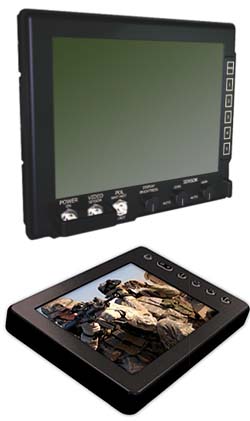Ultra-rugged waterproof displays
In RuggedPCReview we usually cover mobile computers, i.e. systems that combine processing, storage, data input and display all in one unit. That, however, doesn’t mean that all mobile systems are all-in-one type of devices. Tablets and slates, for example, are often used in conjunction with an external display and full-size keyboard when used in a stationary environment, and there really is no compelling need for vehicle and panel mount systems to be all-in-one.
I was reminded of that when I came across some very interesting display products from a company called Digital Systems Engineering, located in Scottsdale, Arizona. They have the DVE Raptor display where DVE stands for “Driver Vision Enhancement.” It is a ruggedized LCD display designed to operate under the kind of extreme environmental conditions encountered in tactical wheeled and tracked vehicles. The 10.4-inch SVGA display is sunlight readable with a super-strong 1,000 nits backlight (standard notebooks have less than 200 nits), good vertical an horizontal viewing angles, and zero color shift.
 What’s most amazing, though, is the Raptor display’s environmental specs. It carries an IP67 rating, which means it is not only totally sealed against dust, but it is also waterproof to the extent where it is submersible. Hopefully that won’t happen in a tactical vehicle, but this display will continue to operate under water. It can also operate in an extremely wide temperature range of -40 to 158 degrees Fahrenheit, handle any degree of humidity, and operate at 45,000 feet of altitude. Needless to say, the milled aluminum and heavily sealed and protected display has been shock and vibration tested to MIL-STD-810F specs.
What’s most amazing, though, is the Raptor display’s environmental specs. It carries an IP67 rating, which means it is not only totally sealed against dust, but it is also waterproof to the extent where it is submersible. Hopefully that won’t happen in a tactical vehicle, but this display will continue to operate under water. It can also operate in an extremely wide temperature range of -40 to 158 degrees Fahrenheit, handle any degree of humidity, and operate at 45,000 feet of altitude. Needless to say, the milled aluminum and heavily sealed and protected display has been shock and vibration tested to MIL-STD-810F specs.
The screen, which only weighs a bit over eight pounds, is also MIL-STD-3009 compliant. MIL-STD-3009 (also referenced as DOD-STD-3009) sets requirements for aircraft display equipment for use with night vision imaging systems. For mobile computers that generally means they must not interfere with night vision equipment in a cockpit. Part of this document is the U.S. Navy MIL-HDBK-87213 Revision A (Electronically/Optically Generated Airborne Displays) that describes, among other, criteria for legibility of electro-optical display equipment and daylight readability in bright environments, which is a military requirement. This can be an issue with daylight readable displays marketed to the govenment and armed forces.
If the indestructible Raptor is overkill, Digital Systems Engineering has a line of MSM monitors where MSM stands for Mil Spec Monitor. These come in various display sizes (8, 10, 12, 15) and are lighter than the Raptor. Despite IP67 sealing, they only weigh between 3.5 (8.4-inch display) and 6.9 pounds (15 inch display). Yet, the MSMs are MIL-STD-3009, MIL-L-85762A and MIL-PRF-22885 compliant and have an incredibly bright 1,400 nit backlight in addition to anti-reflective and anti-glare surface treatment, making them viewable under any lighting conditions.
To learn more about those super-rugged monitors, check Digital Systems Engineering’s website at http://www.digitalsys.com.